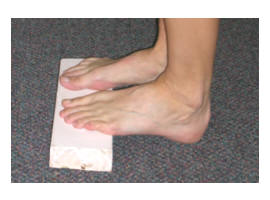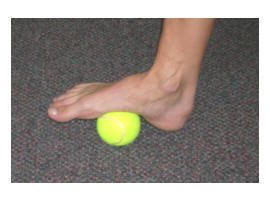|
Treatments
- Comprehensive
care of foot and ankle related disorders
- Diabetic foot and
ankle care
- Routine foot and
ankle care services
- Non-surgical
treatment of athletic injuries
- Custom-molded
Orthotic shoe gear
- Diabetic Shoe
Gear Program
- Foot and ankle
surgery
- Work related
injuries
- Minor in-office
surgical procedures
Contrast Baths
Contrast baths are incredibly effective at helping to
decrease swelling, while increasing the circulation to
an injury.
Here's what to do: Use two
medium pales of water. The 1st one should
have cool tap water with 10-12 ice cubes in it. The 2nd
one should have warm, not hot water (about 100�)
in it. Put your foot in the cool water for one
minute. Then immediately in the warm water for 4-5
minutes. Go back to the cool for 1 minute, then the
warm again for 4-5 minutes. Repeat this cycle three
times. Always
start and stop in the cool water.
Cool Warm
Cool Warm Cool
1
min 4 min 1 min
4 min 1 min
Don't
be surprised if you have an unpleasant "tingling"
sensation at first, this will go away.
Cold ACE Wrap
Instead of an ice pack, I recommend you keep two Ace
wraps (4" brown elastic bandage) in a small dish of
water in the refrigerator: NOT the freezer.
When
you get home at the end of the day, or after
exercising, take the Ace wrap out of the water; wring
out the extra water; wrap the foot, ankle and lower leg
snugly with this cool damp elastic wrap. Keep the wrap
on for 20 -- 30 minutes while going about your
business. Then unwrap and simply put the Ace bandage
back in the dish of water in the refrigerator. In an
acute injury, you may want to do this 2-3 times per
day.

Stretching
Stretching is a nuisance, but it may be the single
most important thing you do, while recovering.
Luckily, stretching the Achilles tendon and the ankle
is simple. Get a piece of wood (preferably a 2X4)
about 18" long. If you don't have a 2X4, a phone
book (business pages) works as well. Place on the
floor next to the bathroom or kitchen sink (someplace
where you stand a lot).
Every
time you walk up to the sink to wash your hands, brush
your teeth, etc., put your toes on the board and hang
your heels off on the floor. You should feel a gentle
stretch or tightness in the back of the calf. The
beauty of this stretch is that you don't have to think
about it, and stretching a muscle 10 times/day for 10
seconds each is much more effective than stretching
once a day for 10 minutes!

Massage
Massage plays a significant role in mobilizing swelling
and inflammation, and speeds up the healing process.
Massage should be slightly uncomfortable to be
effective (it should not bring tears to your eyes).
Massaging the arch is simple. Find a place where you
sit routinely and place a tennis ball on
the floor.
Alternatively, some people will take a plastic
bottle, fill it with water & leave in the
freezer, and use this to massage the arch. Simply rub
the arch back and forth over the tennis ball (or frozen
bottle) to massage the area. If there is a point of
maximum tenderness, slowly work the ball around this
point and focus on working the inflammation out from
the area.
Soaks
Soaks
are used for helping relief pain, fight infections and
dry out (to speed healing) open wounds. Water
temperature for soaking should be warm (~100�
F.) NOT HOT. It is very easy to burn the foot
if the water is too hot. So always check the
water temperature with your fingers before putting your
foot in to soak.
There
are 2 choices to use in the water: 1st is
Epsom salts - ~3 tablespoons of Epsom salts in
enough water to go just below the ankle. Feel free to
use table salt should Epsom salt not be available. 2nd
� we often recommend the use of Domeboro powder
or tablets (this is available over the counter; ask
your pharmacist to help you find it). One packet in
enough water to go just below the ankle is again the
correct concentration. Feet should be soaked for
10 minutes.
Make
sure to dry well (including between the toes!).
Apply a very small amount of triple antibiotic cream
(don�t apply too much) if there is an open area or
infection. The area should be covered with a band-aid
during the day, and left open at night. Any
increase in redness, pain or drainage warrants an
immediate call to the office (even if it is after hours).

|



